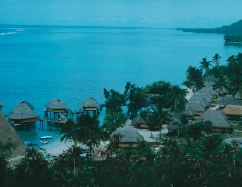| Trouble in Paradise
John Lauerman Abstract
 Once a "tropical paradise," the Pacific Islands are undergoing dramatic changes due to forces such as population growth, the world economy, westernization, and exploitation by foreign powers. Health indicators range widely in the Pacific Islands. In Hawaii, for example, the average life expectancy is 72 years, while in Papua New Guinea the life expectancy is only 49.6 years and infant mortality is 72 per 1,000 live births. Once a "tropical paradise," the Pacific Islands are undergoing dramatic changes due to forces such as population growth, the world economy, westernization, and exploitation by foreign powers. Health indicators range widely in the Pacific Islands. In Hawaii, for example, the average life expectancy is 72 years, while in Papua New Guinea the life expectancy is only 49.6 years and infant mortality is 72 per 1,000 live births. Maintaining adequate supplies of drinking-quality water can be a challenge on many Pacific Islands. Islanders depend on rainfall to replenish drinking water supplies, and the pit toilets common throughout the islands can compromise water sources. Agriculture is another source of water pollution ; chemicals used in pineapple cultivation have been detected in drinking water on several of Hawaii's islands. Fluctuations in water supply may also contribute to local outbreaks of water- and mosquito-borne diseases such as cholera, dengue fever, and malaria. It is thought that aberrant weather patterns influenced by El Niño may also play an important role in causing such outbreaks. Global warming is another threat. Various researchers have predicted that the sea will rise 40-60 cm in the next century. Atoll nations, which already sit only a few feet above sea level, are concerned about the possibility of watching their islands sink below the ocean's surface. In addition to flooding, sea level rise has the potential to affect a variety of health factors such as agriculture, fishing, availability of fresh water, contamination of fresh water due to disruption of sanitation, overall economic decline, and health effects due to population displacement. Non-native diseases have plagued the Pacific Islands since los conquistadores first brought venereal diseases in the 16th century. Today, several diseases associated with urbanization, modernization, and westernization have taken hold in the Pacific Islands. For instance, rates of hepatitis B are approximately 30 times higher in the Marshall Islands than in the mainland United States. Atmospheric nuclear testing conducted in the Marshall Islands during the 1940s and 1950s has left that area with high rates of thyroid disease and thyroid cancers. Many other forms of cancer appear more frequently in both men and women and claim more lives than on the mainland. Growing populations strain the resources of many of the smaller islands, and new dietary and lifestyle patterns have had widespread deleterious effects on health.
The full version of this article is available for free in HTML format. |

